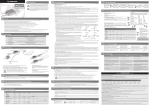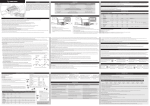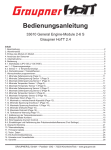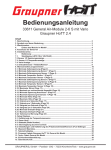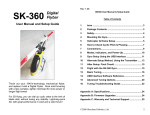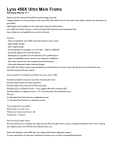Transcript
ATTENTION
USER MANUAL
Brushless Electronic Speed Controller
Platinum HV-200A-OPTO
CAUTIONS
Thank you for purchasing this HOBBYWING product! Brushless power systems can be very
dangerous. Any improper use may cause personal injury and damage to the product and
related devices. We strongly recommend reading through this user manual before use. Because
we have no control over the use, installation, or maintenance of this product, no liability may
be assumed for any damages or losses resulting from the use of the product. We do not
assume responsibility for any losses caused by unauthorized modifications to our product.
01 Features
• High performance microprocessor with a running frequency of up to 120MHz for excellent motor
speed-governing and super soft startup.
• Microprocessor powered by independent DC regulator has better anti-interference performance, which greatly
reduces the risk of losing control.
• The maximum motor speed can reach 210000 RPM (for 2 pole motor), 70000 RPM (for 6 pole motor) and
35000 RPM (for 12 pole motor).
• Multiple flight modes: Fixed-wing, Heli (Linear Throttle Response), Heli (Elf Governor), and Heli (Store Governor).
• Data logging records the standardized RPM, minimum voltage, maximum current and maximum temperature
of the flight.
• "Restart in auto rotation" can manually interrupt the auto rotation and quickly restart the motor to avoid
crashes caused by incorrect operations.
• WIFI module (sold separately) for programming the ESC wirelessly with your smart phone (ios or Android).
• Internal anti-spark circuitry effectively eliminates electric sparks produced when the ESC is powered on.
• Independent output port for RPM (that is: motor speed) signals.
• Separate programming port for ESC programming or parameter setting.
• Multiple protections like thermal shutdown protection, overload protection, over-current protection, etc.
• Online firmware upgrade via HOBBYWING multifunction LCD program box or WiFi module.
02 Begin to Use the New Brushless ESC
1
Connections
Specifications
Battery
Model
Platinum 200A HV V4
Main Application
700-800 class Helis
Input Voltage
6S-14S Lipo
Cont./Peak Current
200A/250A (in 10 seconds)
BEC output
NO
Programming (PRG)/Cooling fan Port
For connecting the LCD program box/WiFi module or Cooling fan
Throttle Signal/RPM Signal Transmission
Via Optical Coupler
Input/output Wires
10AWG/10AWG
Weight/Size
305g (with input & output wires soldered to ESC)/106x50x40mm
Platinum HV-200A-OPTO
04 Explanations for Programmable Items
1. Flight Mode
1.1 In “Fixed Wing” mode, the motor will start up when the throttle amount reaches 5% or above. There is no soft start-up, the motor responds to the throttle increase rapidly.
1.2 In “Heli (Linear Throttle Response)” mode, the motor will start up in a very soft way when the throttle amount reaches 5% or above. And it will accelerate to the RPM corresponds to the specific throttle amount in the preset start-up
time (4~25s).
1.3 In “Heli (Elf Governor)” mode, the motor will start up when the throttle amount reaches 40% or above, it will start up in a very soft way. And it will complete the speed standardization and enter the speed-governing operation in the
preset start-up time. In this mode, the motor will standardize its speed every time it starts up. Due to different discharge rates/capabilities of different batteries, the RPM you standardize each time may be a little different.
In consequence, at the same throttle amount, the RPM may be a bit different when using different batteries.
1.4 In “Heli (Store Governor)” mode, the motor will start up when the throttle amount reaches 40% or above. It will also start up in a very soft way. And it will also complete the speed standardization and enter the speed-governing
operation in the preset start-up time. In this mode, the motor will only standardize its speed the first time when it starts up. When performing RPM standardization for the first time, we recommend using a fully-charged battery with
good discharge capability. After the RPM standardization, while you change another battery to fly your aircraft, at the same throttle amount, the RPM will always be the same as the RPM of the first flight. For consistent control feel,
we recommend using this mode.
Explanations for RPM Standardization
1.1.The motor will enter the soft start-up when user switches the throttle amount from 0 to 40% or above (50% throttle is recommended). The pitch of main blades should be 0 degree during the soft start-up process, the RPM
standardization completes when the soft start-up ends, and the ESC enters the speed-governing state. In "Heli (Store Governor)" mode, if user wants to re-standardize the speed, he needs to set the flight mode to “Heli (Elf
Governor)” and save this mode first, and then reset the flight mode back to “Heli (Store Governor)”, then the ESC will re-standardize the motor speed when the motor rotates for the first time after the ESC is re-powered on.
1.2. For ensuring the speed-governing effect, we recommend setting the throttle amount to 90% or below in both speed-governing modes (Heli Store Governor & Heli Elf Governor), so there will be sufficient compensating room to
maintain the consistency of the RPM. We recommend replacing the motor or adjusting the gear ratio if the expected RPM still cannot be reached when the throttle amount exceeds 90%.
(Note: You need to re-standardize the RPM after replacing the motor, blades, body frame or adjusting the gear ratio.)
1.3. In “Heli Store Governor” mode, if you fly your aircraft with another battery pack that has poor discharge capability after the RPM standardization (with a pack which has good discharge capability), the pack has poor discharge
capability may be get damaged.
2. LiPo Cells: the ESC will automatically calculate the number of LiPo cells you have plugged in as per the “3.7V/Cell” rule if “Auto Calculate” is selected. Or user can set this item manually.
3. Voltage Cutoff Mode: the ESC will gradually reduce the output to 50% of the full power in 3 seconds after the voltage cutoff protection is activated, if soft mode is selected. It will immediately cut off all the output when hard mode is selected.
4. Cutoff Voltage: 2.7V-3.7V (custom), 3.3V (default).
5. BEC Output: No.
6. Start-up Time: 4-25s (adjustable), 1s (step), 15s (default).
7. Governor Parameter P: Control the ESC maintaining the stability of the current motor speed.
8. Governor Parameter I: Control the dynamic response. To be specific, control the supplement extent when the actual motor speed is below expectation. If you choose a very big value, then the supplement may be too much.
If select a very small value, then the supplement may not sufficient.
9. Auto Restart Time: the ESC will cut off its output when the throttle amount is between 25% and 40%. If you increase the throttle amount to above 40% within preset time period (0-90s), the motor will rapidly start up and accelerate to
the speed (in 1s) corresponds to the specific throttle amount, complete the shutdown and restart up.If you move the throttle stick to over 40% beyond the preset time period, the ESC will enter the soft start-up process. (Note: This
function only effects in “Heli Governor Elf/Store” mode.)
10. Timing: 0-30° (adjustable), 1°(step), 15° (default).
11. PWM Frequency: 8KHz/15KHz/20KHz/30KHz (adjustable), 30KHz (default).
12. Brake Force: 0-100% (adjustable), 1% (step), 0 (default).
13. Motor Rotation: CW/CCW. User can adjust this item via a multifunction LCD program box.
14. Restart Acceleration Time: 1s/1.5s/2s/2.5s/3s (adjustable), 2s (default). This item controls the time the motor accelerates from standstill to full speed after the Auto Restart is triggered and your helicopter restarts its flight.
15. Con. Freewheel: User can decide this function “Activated” or “Disabled” in “Fixed Wing” mode or in “Heli (Linear Throttle Response” mode. This item has been preset to “Activated” and cannot be adjusted in
“Heli (Elf Governor/Store Governor) mode. This function can brings better throttle linearity.
05 How to Program Your ESC
ESC programming
With a multifunction LCD program box
Connect the LCD program box and a battery to your ESC as shown above.
ATTENTION:
After adjusting parameters, you need
to power your ESC off and then on.
Otherwise, those new parameters won't
take effect.
Battery
Battery
Press the “OK” button to connect the program box to your ESC. The current firmware version will show up
after the program box is successfully connected to the ESC.
Platinum HV-200A-OPTO
Press the “ITEM” button to browse all the programmable items, and then press the “OK” button to enter any
programmable item you want to set.
1. RPM Signal Wire (yellow): Plug this wire (or wire 1) into the RPM input channel on the flybarless system. (User can use the RPM signal wire to
provide the RPM signal input when using an external governor.)
2. Throttle Signal Wire (white, red and black): Plug this wire (wire 2) into the throttle channel on the receiver or the corresponding channel on the
Press the “Value” button to browse all parameter values after entering the specific programmable item.
flybarless system like the RX B channel on the VBAR system. Which channel you should plug the wire in depends on the specific kind of receiver and
Motor
Battery
flybarless system you use. The White wire is for transmitting throttle signals, The Red wire is for powering the built-in optical coupling module,
Press the “OK”button to save the new parameter value you just selected.
and it supports the input voltage ranges from 5V to 8V. The Black wire is the GND wire.
Connecting your ESC to a multifunction LCD program box
2
via the extra 3 pin cable (with JR male connectors at
Throttle Range Calibration
Attention! The default throttle range of this ESC is from 1100µs to 1940µs, so you need to re-calibrate the throttle range when the first time you use this ESC or after you replace the transmitter.
1.Connections before the Throttle Range Calibration:As shown above (Wiring Diagram 1)
2.ESC/Radio Calibration
With a WiFi Module: Please refer to the user manual of the Hobbywing WiFi module.
both ends) by referring to corresponding marks
Motor
("-+s" & "ESC") on the ESC and the program box.
06 Data Checking and Normal Start-up Process
Turn on the transmitter, move the
The ESC will keep beeping indicating the
2 seconds later, the motor will
Move the throttle stick to the
ESC/radio calibration
throttle stick to the top position, and
number of LiPo cells you have plugged in. (A
emit two short beeps indicating
bottom position in 3 seconds.
completed, the power
Data Checking
connect the ESC to a battery. The
long beep represents 5, a short beep represents
the maximum throttle position
1 second later, a short beep will
system is ready to go.
motor will emit “♪123” indicating
1. E.g. The ESC will beep two long beeps and
has been successfully calibrated
emit indicating the minimum
the ESC is powered on normally.
two short beeps to indicate a 12S LiPo pack.
and accepted.
throttle position has been accepted.
The ESC will record the standardized RPM, minimum voltage, maximum current, maximum temperatures of the
current flight but won’t save these data, so you need to keep the ESC on if you want to check the information
of the current flight.
ATTENTION!
Turn on the transmitter, and then move the throttle stick to the bottom position.
Connect the LCD program box and a battery to your ESC as shown above.
After connected to a battery, the ESC will emit “♪ 123” indicating it’s normally powered on.
Press the “OK” button to connect the program box to your ESC. The current firmware
version will show up after the program box is successfully connected to the ESC.
The motor will emit several beeps to indicate the number of LiPo cells.
During the ESC/Radio calibration, please set the throttle curve to NORMAL and ensure the corresponding throttle amounts to the maximum throttle endpoint and the minimum throttle
endpoint on your transmitter are respectively 100% and 0%.
03 Programmable Item List
The motor emits a long beep indicating the ESC is ready to go.
Press the “R/P” button to browse all running information relates to the ESC.
“*”in the form below indicate factory defaults.
Programmable Items
1. Flight Mode
2. LiPo Cells
3. Voltage Cutoff Mode
4. Cutoff Voltage
5. BEC Output
6. Start-up Time
Parameter Values
Option 1
Option 2
Option 3
Option 4
Fixed-wing
Heli (Linear Throttle Response)
*Heli (Elf Governor)
Heli (Store Governor)
*Auto Calculate
6S
8S
10S
*Soft
Hard
Option 5
Option 6
12S
14S
Option 7
2.7-3.7V (*3.3V)
4-25s (*15s)
0-9 (*3)
You can increase the governor sensitivity (P, I) if you think the governor feel is weak. However, extreme high sensitivity will cause
8. Governor Parameter I
0-9 (*5)
unstable RPM. To be specific, the RPM will float up/down around the preset value.
9. Auto Restart Time
0-90s (*25s)
10. Timing
0-30° (*15°)
11. PWM Frequency
12. Brake Force/Amount
13. Motor Rotation
14. Restart Acceleration Time
8Khz
Notes: 1. you can only check the standardized RPM in “Heli Store Governor” mode, this record won’t disappear
after you turn off the ESC.
2. The recorded revs are electric revs. If the electric rev is R, the actual rev of
blades=R ÷ Motor Poles ÷ 2 ÷ Gear Ratio x throttle amount(%).
20Khz
Possible Causes
LED Status
Over-current protection is activated.
The current is above 350A.
Red LED turns on solid.
Throttle Signal Loss.
No throttle signal is received
for over 0.25 second.
Red LED blinks once and repeats.
Abnormal power voltage.
Power voltage is not within
18.5-51.8V (or 6-14S).
Red LED blinks twice and repeat.
Thermal shutdown protection is activated.
The ESC temperature is over
110℃ (230℉)
Blue LED blinks once and repeats.
Low voltage cutoff protection is activated.
15Khz
The voltage goes below the
cutoff voltage.
Multiple Protections
Start-up Protection
Thermal Shutdown
Protection
Blue LED blinks twice and repeat.
*30Khz
Throttle Signal
Loss Protection
0-100% (*0)
CW
Warning Tone
CCW
1s
1.5s
Activate
Disable
*2s
2.5s
3s
This item can only be disabled in Fix-wing mode and Heli (Linear Throttle Response) mode.
During the normal running process, the Blue LED on the ESC will turn solid after the
start-up completes. The Red LED will also come on at full throttle and it dies out at
partial throttle. (Please refer to the following form for detailed instructions.)
07 Troubles & Status LEDs
Trouble(s)
No
7. Governor Parameter P
15. Con.Freewheel
Normal Start-up Process
Possible Issue
“Beep beep, beep beep”(The interval is 1 sec)
Abnormal input voltage.
“Beep-beep-”(The short, single beep that
repeats rapidly)
The throttle stick isn’t moved to the bottom
position (before use) or the throttle range is too narrow.
How to Protect
The ESC will monitor the motor speed during the start-up process. When the speed stops increasing or the
speed increase is not stable, the ESC will take it as a start-up failure. At that time, if the throttle amount is
less than 15%, the ESC will automatically try to restart up; if it is larger than 15%, you need to move the
throttle stick back to the bottom position and then restart up the ESC.
The ESC will gradually reduce the output but won’t cut it off completely when the ESC temperature goes
above 230℉. For ensuring the motor can still get some power and won’t cause crashes, so the maximum
reduction is about 50% of the full power. The ESC will gradually resume its maximum power after the
temperature lowers down. In addition, the ESC temperature cannot exceed 158℉ when it’s powered on.
Otherwise, it cannot be started up. (Here we are describing the ESC’s reaction in soft cutoff mode, while if in
hard cutoff mode; it will immediately cut off the power.)
When the ESC detects loss of signal for over 0.25 second, it will cut off the output immediately to avoid an
even greater loss which may be caused by the continuous high-speed rotation of propellers or rotor blades.
The ESC will resume the corresponding output after normal signals are received.
Overload Protection
The ESC will cut off the power/output or automatically restart itself when the load suddenly increases to a
very high value. Possible cause to sudden load increase is that propellers are blocked.
Over-current Protection
The ESC will cut off the power when the current gets close to the short circuit current (of 350A). This
protection may be activated by the burnt motor or some others.
